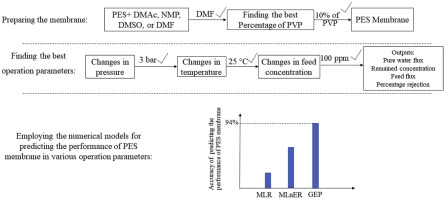当前位置:
X-MOL 学术
›
J. Environ. Manag.
›
论文详情
Our official English website, www.x-mol.net, welcomes your feedback! (Note: you will need to create a separate account there.)
Gene expression programming for process parameter optimization during ultrafiltration of surfactant wastewater using hydrophilic polyethersulfone membrane.
Journal of Environmental Management ( IF 8.7 ) Pub Date : 2020-03-24 , DOI: 10.1016/j.jenvman.2020.110444 Aydin Shishegaran 1 , Arash Nazem Boushehri 2 , Ahmad Fauzi Ismail 3
Journal of Environmental Management ( IF 8.7 ) Pub Date : 2020-03-24 , DOI: 10.1016/j.jenvman.2020.110444 Aydin Shishegaran 1 , Arash Nazem Boushehri 2 , Ahmad Fauzi Ismail 3
Affiliation

|
Surfactants are the emerging contaminant and cause a detrimental effect on the ecosystem. In this study, an attempt is made to removal anionic surfactant Sodium dodecyl sulfate (SDS) containing wastewater using hydrophilic polyvinylpyrollidone (PVP) (5-15 wt%) modified polyethersulfone (PES) ultrafiltration membrane. The influence of operating variables on membrane performance was also sequentially analyzed using tests and three numerical modeling methods such as multiple linear regression (MLR), multiple Ln-equation regression (MLnER), and gene expression programming (GEP). Contact angle value of 10 wt% PVP modified PES membrane decreased up to 23.8°, whereas the neat PES membrane is 70.7°. This study indicates that the required hydrophilic property was improved in the modified membrane. The water flux and porosity also enhanced in PVP modified PES membranes. In performance evaluation, the optimum operating variable condition of transmembrane pressure (TMP), feed concentration, and the temperature is found to be 3 bar, 100 ppm, and 25 °C, respectively. Among the models, GEP has a good correlation with experimental anionic surfactant SDS filtration data. GEP performs better than other model with respect to statistical parameter and error terms. This study provides an insight into an adaptation of novel numerical modeling methods for the prediction of membrane performance to the treatment of surfactant wastewater.
中文翻译:

使用亲水性聚醚砜膜进行表面活性剂废水超滤过程中工艺参数优化的基因表达程序设计。
表面活性剂是新出现的污染物,会对生态系统造成不利影响。在这项研究中,尝试使用亲水性聚乙烯吡咯烷酮(PVP)(5-15 wt%)改性的聚醚砜(PES)超滤膜去除阴离子表面活性剂十二烷基硫酸钠(SDS)。还使用测试和三种数值建模方法(例如多元线性回归(MLR),多元Ln方程回归(MLnER)和基因表达编程(GEP))顺序分析了操作变量对膜性能的影响。10 wt%PVP改性的PES膜的接触角值降低到23.8°,而纯PES膜的接触角值为70.7°。这项研究表明所需的亲水性在改性膜中得到了改善。在PVP改性的PES膜中,水通量和孔隙率也得到增强。在性能评估中,发现跨膜压力(TMP),进料浓度和温度的最佳操作变量条件分别为3 bar,100 ppm和25°C。在这些模型中,GEP与实验性阴离子表面活性剂SDS过滤数据具有良好的相关性。就统计参数和误差项而言,GEP的性能优于其他模型。这项研究提供了一种新的数值建模方法的适应性,用于预测膜性能对表面活性剂废水的处理。在这些模型中,GEP与实验性阴离子表面活性剂SDS过滤数据具有良好的相关性。就统计参数和误差项而言,GEP的性能优于其他模型。这项研究提供了一种新的数值建模方法的适应性,用于预测膜性能对表面活性剂废水的处理。在这些模型中,GEP与实验性阴离子表面活性剂SDS过滤数据具有良好的相关性。就统计参数和误差项而言,GEP的性能优于其他模型。这项研究提供了一种新的数值建模方法的适应性,用于预测膜性能对表面活性剂废水的处理。
更新日期:2020-03-26
中文翻译:

使用亲水性聚醚砜膜进行表面活性剂废水超滤过程中工艺参数优化的基因表达程序设计。
表面活性剂是新出现的污染物,会对生态系统造成不利影响。在这项研究中,尝试使用亲水性聚乙烯吡咯烷酮(PVP)(5-15 wt%)改性的聚醚砜(PES)超滤膜去除阴离子表面活性剂十二烷基硫酸钠(SDS)。还使用测试和三种数值建模方法(例如多元线性回归(MLR),多元Ln方程回归(MLnER)和基因表达编程(GEP))顺序分析了操作变量对膜性能的影响。10 wt%PVP改性的PES膜的接触角值降低到23.8°,而纯PES膜的接触角值为70.7°。这项研究表明所需的亲水性在改性膜中得到了改善。在PVP改性的PES膜中,水通量和孔隙率也得到增强。在性能评估中,发现跨膜压力(TMP),进料浓度和温度的最佳操作变量条件分别为3 bar,100 ppm和25°C。在这些模型中,GEP与实验性阴离子表面活性剂SDS过滤数据具有良好的相关性。就统计参数和误差项而言,GEP的性能优于其他模型。这项研究提供了一种新的数值建模方法的适应性,用于预测膜性能对表面活性剂废水的处理。在这些模型中,GEP与实验性阴离子表面活性剂SDS过滤数据具有良好的相关性。就统计参数和误差项而言,GEP的性能优于其他模型。这项研究提供了一种新的数值建模方法的适应性,用于预测膜性能对表面活性剂废水的处理。在这些模型中,GEP与实验性阴离子表面活性剂SDS过滤数据具有良好的相关性。就统计参数和误差项而言,GEP的性能优于其他模型。这项研究提供了一种新的数值建模方法的适应性,用于预测膜性能对表面活性剂废水的处理。



























 京公网安备 11010802027423号
京公网安备 11010802027423号